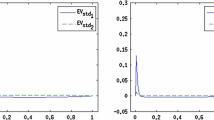Abstract
The Raviart–Thomas mixed finite-element method of the lowest order (Raviart and Thomas in mixed finite-element methods for second-order elliptic problems, Lecture Notes in mathematics, Springer, New York, 1977) commonly known as the \(RT_0\) method, is a well-established and popular numerical tool to solve diffusion-like problems providing flux continuity across inter-element boundaries. Douglas and Roberts extended the method to the case of more general second-order boundary-value problems including the convection–diffusion equations (cf. this journal Douglas in Comput Appl Math 1:91–103; 1982). The main drawback of these methods, however, is the poor representation of the primal variable by piecewise constant functions. The Hermite analog of the \(RT_0\) method for treating pure diffusion phenomena proposed in Ruas (J Comput Appl Math, 246:234–242; 2013) proved to be a valid alternative to attain higher order approximation of the primal variable while keeping intact the matrix structure and the quality of the discrete flux variable of the original \(RT_0\) method. Non-trivial extensions of this method are studied here that can be viewed as Hermite analogs of the two Douglas and Roberts’ versions of the \(RT_0\) method, to solve convection–diffusion equations. A detailed convergence study is carried out for one of the Hermite methods, and numerical results illustrate the performance of both of them, as compared to each other and to the corresponding mixed methods.
Similar content being viewed by others
References
Adams RA (1975) Sobolev spaces. Academic Press, New York
Babuška I (1973) The finite element method with Lagrange multipliers. Numer Math 20:179–192
Beirão da Veiga L, Brezzi F, Cangiani A, Manzini G, Marini D, Russo A (2013) Basic principles of virtual element methods. Math Models Methods Appl Sci 23:199–214
Brezzi F, Fortin M (1991) Mixed and hybrid finite element methods. Springer, New York
Brunner F, Radu FA, Bause M, Knabner P (2012) Optimal order convergence of a modified BDM1 mixed finite element scheme for reactive transport in porous media. Adv Water Resour 35:163–171
Brunner F, Radu FA, Knabner P (2014) Analysis of an upwind-mixed hybrid finite element method for transport problems. SIAM J Numer Anal 52:83–102
Burman E, Stamm B (2010) Bubble stabilized discontinuous Galerkin method for parabolic and elliptic problems. Numer Math 116:213–241
Ciarlet PG (1978) The finite element method for elliptic problems. North Holland, Amsterdam
Demlow A (2002) Suboptimal and optimal convergence in mixed finite element methods. SIAM J Numer Anal 39:1938–1953
Douglas J Jr, Roberts JE (1982) Mixed finite element methods for second order elliptic problems. Comput Appl Math 1:91–103
Evans LC (2010) Partial differential equations. Graduate studies in mathematics, 2nd edn. American Mathematical Society, Providence, RI
Cottrell JA, Austin J, Hughes TJR, Bazilevs Y (2009) Isogeometric analysis: toward integration of CAD and FEA. Wiley, New York
Cuminato JA, Ruas V (2015) Unification of distance inequalities for linear variational problems. Comput Appl Math 34–3:1009–1033
Grisvard P (1985) Elliptic problems in non smooth domains. Pitman, Boston
Ikeda T (1983) Maximum Principle in Finite Element Models for Convection-diffusion Phenomena. In H. Fujita and M. Yamaguti (eds) Lecture Notes in Numerical and Applied Analysis Vol. 4, North-Holland Mathematical Studies 76, North Holland/Kinokuniya
Kim D, Park E-J (2008) A posteriori error estimators for the upstream weighting mixed methods for convection-diffusion problems. Comput Methods Appl Mech Eng 197:806–820
Lovadina C, Stenberg R (2006) A posteriori error analysis of mixed finite element methods for second order elliptic equations. Math Comput 75:1659–1674
Radu FA, Suciu N, Hoffmann J, Vogel A, Kolditz O, Park C-H, Attinger S (2011) Accuracy of numerical simulations of contaminant transport in heterogeneous aquifers: a comparative study. Adv Water Resour 34:47–61
Raviart PA, Thomas JM (1977) Mixed finite element methods for second order elliptic problems. Springer, New York Lecture Notes in Mathematics
Ruas V (1979) Automatic generation of triangular finite element meshes. Comput Math Appl 5–2:125–140
Ruas V (2013) Hermite finite elements for second order boundary value problems with sharp gradient discontinuities. J Comput Appl Math 246:234–242
Ruas V, Brandão D, Kischinhevsky M (2013) Hermite finite elements for diffusion phenomena. J Comput Phys 235:542–564
Ruas V, Trales P (2013) A Hermite finite element method for convection-diffusion equations. In Simos T. et al. ed. AIP Proceedings of the 11th International Conference Numerical Analysis and Applied Mathematics, Rhodes, Greece
Strang GJ, Fix G (1973) An analysis of the finite element method. Prentice Hall, Englewood Cliffs
Thomas J.-M (1977) Sur l’analyse numérique des méthodes d’éléments finis hybrides et mixtes, Thèse de Doctorat d’Etat, Université Pierre et Marie Curie, Paris 6
Acknowledgements
The first author is thankful for the financial support provided by CNPq through Grant 307996/2008-5 and the second author gratefully acknowledges the support of Statoil through the Akademia agreement.
Author information
Authors and Affiliations
Corresponding author
Additional information
Communicated by Jorge X. Velasco.
Rights and permissions
About this article
Cite this article
Ruas, V., Radu, F.A. Hermite analogs of the lowest order Raviart–Thomas mixed method for convection–diffusion equations. Comp. Appl. Math. 37, 2693–2713 (2018). https://doi.org/10.1007/s40314-017-0474-5
Received:
Revised:
Accepted:
Published:
Issue Date:
DOI: https://doi.org/10.1007/s40314-017-0474-5




